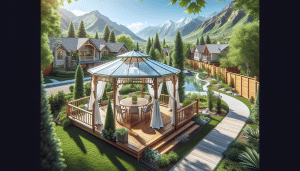When planning to upgrade your outdoor living space, homeowners often face the great decking dilemma: composite decking vs. wood. At Utah Deck Supply, we understand this is a significant decision that can affect not only the aesthetics of your home but also your lifestyle and budget. That’s why we’ve crafted this comprehensive guide to help you navigate the key differences between these two popular decking options. By the end of this read, you’ll be equipped with the knowledge needed to make the best choice for your unique needs.
Understanding Composite Decking
Composite decking is engineered from a blend of wood fibers and plastic. It’s designed to mimic the appearance of wood while offering enhanced durability and reduced maintenance requirements. This material has gained popularity for its long-lasting nature and low environmental impact. Homeowners looking for a modern, hassle-free option often gravitate toward composite decking.
One of the primary benefits of composite decking is its resistance to common issues like rot, warp, and insect damage. This makes it an excellent choice for individuals seeking a low-maintenance solution that doesn’t compromise on aesthetics.
All About Wood Decking
Wood decking, a classic choice, provides a natural look that has been loved for centuries. Options like Cedar, redwood, and pressure-treated pine are commonly used due to their availability and affordability. Wood offers a unique charm that some homeowners find irreplaceable, bringing warmth and a sense of tradition to outdoor spaces.
However, maintaining a wood deck can be labor-intensive. Regular staining, sealing, and inspections for rot or pest damage are necessary components of wood deck upkeep. Yet, there are many who enjoy the process, finding satisfaction in the customizable and authentic aspects of a wood deck.
Maintenance: A Tale of Two Materials
When comparing maintenance requirements, composite decking undoubtedly requires less effort. The engineered design ensures that composite decks remain vibrant and sturdy with minimal intervention. A simple cleaning with soap and water usually suffices.
On the flip side, wood decking necessitates a more hands-on approach. Annual sealing and staining are a must to preserve the wood’s beauty and longevity. While this may seem daunting, many homeowners enjoy the opportunity to rejuvenate their outdoor space each year.
The Cost Factor
Budget plays a crucial role in the decking decision. It’s important to consider both the initial investment and long-term costs associated with each option. Composite decking typically demands a higher upfront cost compared to wood.
However, the reduced maintenance expenses over the lifespan of the deck can make composite a cost-effective choice in the long run. Conversely, wood decking might seem more affordable initially, but regular maintenance will add to its total expense.
Environmental Impact Considerations
Green-minded homeowners will appreciate the sustainable aspects of both decking materials. Composite decking often includes recycled materials, contributing to environmental preservation. Many brands make efforts to source ethically and reduce waste during production.
Wood decking, if sourced responsibly, can also be an eco-friendly choice. Utilizing wood from sustainably managed forests ensures that natural resources are preserved for future generations.
Aesthetic Appeal: Choosing Your Style
In terms of appearance, both composite and wood decking have distinct qualities that appeal to various tastes. Composite boards can imitate the look of natural wood while offering a wide range of colors and finishes for modern designs.
Wood, with its unique grain patterns and shades, brings a more traditional vibe. It can be customized through staining and paint, allowing homeowners to craft a personalized outdoor space that truly feels like an extension of their home.
Durability and Longevity
When talking longevity, composite decking stands out as the winner. Engineered to withstand the elements, composite decks do not succumb to fading, stains, scratches, or mold as easily as wood does. This resilience ensures that they maintain their elegance over time with minimal upkeep.
Wood decks, while beautiful, are more prone to damage from weather and daily wear. With proper care, they can last for many years, but they generally require more attention to maintain their Structural integrity and appearance.
Our Recommendations: Key Factors to Consider
- Budget: Consider both initial and long-term costs when choosing your decking material.
- Maintenance: Determine how much time and effort you’re willing to invest in upkeep.
- Climate: The weather in your area can affect the performance and durability of the decking material you choose.
- Environmental Impact: Evaluate the sustainability of the materials used, depending on your environmental goals.
- Aesthetic Preference: Choose a material that aligns with your personal taste and complements your outdoor space
Conclusion: Making Your Decision
Choosing between composite and wood decking demands careful consideration. Each has its benefits and drawbacks, and the right choice will depend on your lifestyle, preferences, and financial planning. Remember, the best deck is one that fits your needs and satisfies your vision for a perfect outdoor retreat.
How Utah Deck Supply Can Help
At Utah Deck Supply, we’re committed to aiding homeowners in achieving their dream outdoor spaces. Our experience and expertise empower us to provide tailored solutions that address the unique challenges and opportunities of your landscape.
If you have any questions or need further assistance in your decking journey, our team is just a phone call away. Let us help you create a space where you can relax, entertain, and enjoy the natural beauty of your surroundings.
For personalized advice and professional service, contact Utah Deck Supply at 385-993-5492 or Request a Free Quote.




